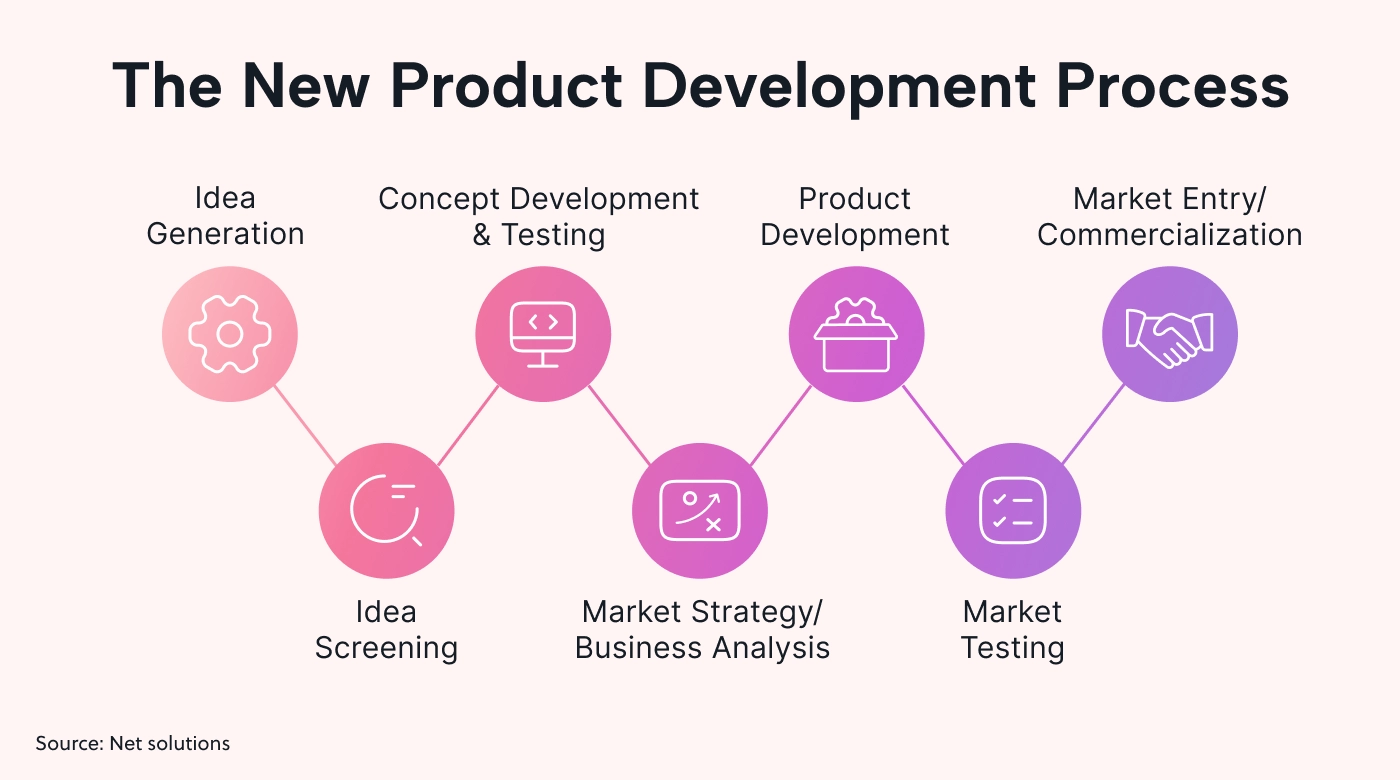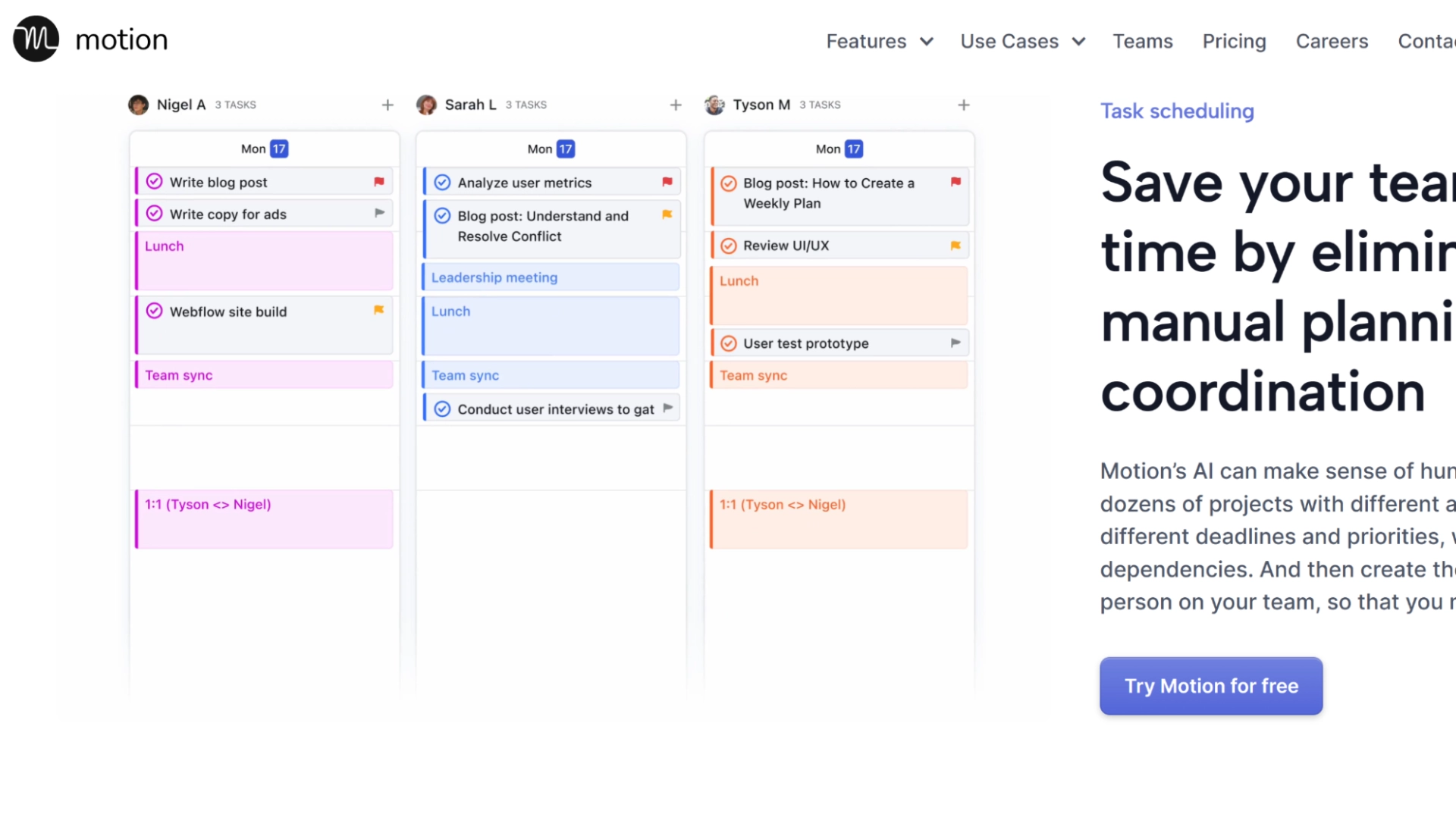According to the Product Plan 2023 State of Product Management Report, standardized and consistent processes are key to navigating the chaos of product development.
You need dependable processes to deliver the value your customers want while allowing you to innovate and try new things.
In this 10-minute guide, we’ll show you exactly how to take a raw idea and turn it into a viable product your customers will love.
This guide is packed with clear, actionable steps to help you navigate from concept to market launch. You’ll learn how to spark innovation, make smart decisions, and avoid common pitfalls.
Whether you’re a product manager or a small business owner, this quick read is your roadmap to delivering a product that stands out in the market.
What is a “new product” development process?
Product development is a six-step process based on a proof of concept (POC) that can help you create and launch a product or service (e.g., software). These six steps make up the product development life cycle.
But what about developing a new, untested product?
 |
"New Product" Development focuses on new ideas that haven't been tested before. This includes uncertainty on how these products will be developed or if they will stick with users.
A vital part of this process is to thoroughly research your target market. You'll want to discover your users' needs and assess how well your product will meet these needs.
While this differs from the product lifecycle, which is more about how a product performs in the market, the new product development process can be considered a product development cycle.
Product development vs. product management
So, how does product development differ from product management?
Product development is about creating and refining a specific product from inception to a successful product launch.
It's about making the product and getting it out into the market. Once the product is launched, the entire product development process ends.
Product management is about managing the entire product life cycle, including the development process. It goes beyond the product launch into how it serves its purpose, performs in the market, and any improvements or changes needed over time.
Who's responsible for new product development?
The product development team is responsible for the product development stages and involves a variety of roles, including:
- Product managers, who oversee the development and make sure the product meets market needs
- Designers who create the visual and functional aspects of the product
- Product developers, who develop the technical components
- The marketing team prepares strategies for launching and promoting the product
You might also include the customer service and sales teams to field initial feedback and share sales data to help develop your product strategy.
Why is a product development plan important in new product development?
A product development plan is crucial because it guides your product development teams through each stage of creating a new product.
You need a product development plan to:
- Ensure precise (and documented) alignment with your business objectives and market demand.
- Help you manage your resources and timelines effectively.
- Identify potential risks and mitigation strategies early.
- Facilitate clear communication and coordination among different teams.
Your product development plan keeps everyone on the same page and helps your team effectively execute their jobs.
Get the most out of the seven stages of the new product development process
The seven stages of product development chart the course from an idea to taking your product to market. Here's how to get the most out of them:
1. Idea generation
As you’ve likely guessed from the name of this stage, focusing on idea generation is the first phase of developing new products. You might already have a great idea, or you might just want to dip your toe in and see what opportunities await.
To make the most of this stage, rather than starting with one idea, why not develop as many great product ideas as possible?
Brainstorm as a team and collaborate to generate as many creative product ideas as possible — no matter how silly they seem. You never know what you’ll come up with.
 |
Gather input from everywhere. Look for ideas from across all of your teams, customer feedback, and even market studies.
Study your competitors. Check out what they are doing well (and badly) to find where you can do better.
Explore technology. Try using some new tech to come up with fresh ideas and build a broad pool of concepts to test.
Aim to have lots of ideas so you can choose the best ones in the next phase: Idea screening.
2. Idea screening
Now that you have a pool of ideas, get to reviewing them. Go through all the product ideas you have and get rid of any that don't meet basic criteria like cost, time, and technical feasibility.
You can make this easier with a SWOT analysis. Analyze the strengths, weaknesses, opportunities, and threats for each idea. See how they might perform in the market and see if you can spot any potential risks as well as any market trends that could inform your product design.
Compare your ideas with user feedback. Based on what you know about your target customers, what would they think about the ideas?
With your cleaned up list, prioritize your ideas. Decide which ideas are worth pursuing further based on their potential to succeed. Then, choose the best ideas to move forward with development.
With the information you've gathered at this stage, you’re all set to make informed decisions as you go. Now you won’t waste time developing and testing ideas that aren’t truly viable.
3. Concept development and testing
This stage is all about defining product concepts. Clearly describe each selected idea in terms of what the product would look like, how it would function, and who it would benefit.
Then, create a product roadmap. Plan the development, launch, and timeline to create a complete, marketable product.
Pro tip: The more detail you can add to each stage, like what needs to be achieved, by who, and by when, will save you hours later. Plus, this product roadmap can also act as your product development plan.
At this stage, you also want to conduct your concept testing. Test with a small group of your target audience. Gather feedback on functionality and design and see if there is any potential market appeal.
Then, analyze your feedback closely. Does the product meet customer needs and expectations? Be honest here. You haven’t lost any time by trying, and pulling the plug here can save you headaches later.
If you need to, now is the best time to make adjustments. Refine and retest until you feel like your idea stands up to user expectations. This will put you in a much better position come launch time. Plus, your marketing team will have real data to help market it better.
4. Market strategy and business analysis
It's time to get the marketing team involved. You'll want to craft a comprehensive marketing strategy (and plan) detailing how the product will be promoted, priced, distributed, and sold in the market. Be sure to include how it'll meet your product vision and business objectives with a detailed business analysis.
See if the customer service team can give you any real client language to help with the marketing message. These could be common complaints customers have that your product overcomes, or even things they have mentioned that they wish your products had.
 |
Assess the demand, market size, and competitive landscape to forecast the potential success of the product. If you can put a number on it, it might be easier to get buy-in from the product team and stakeholders.
Estimate the cost of bringing the product to market. What is the expected revenue? How quickly will you reach profitability? This will help with budgets and buy-in (if you need it).
5. Product development - a.k.a the prototyping phase
It’s time to roll up those sleeves and start prototyping. Begin by creating a functional prototype of the product to test its design, usability, and effectiveness.
Then, based on your prototype testing, make any necessary adjustments to the product design to make it better and more suited to your customers’ needs.
At this stage, you want to test the prototype under different conditions and scenarios to ensure its reliability, safety, and performance.
Then, depending on the product (whether it’s physical or digital), prepare for mass production by finalizing designs, sourcing materials, and setting up production processes.
You’re nearly there!
Next, develop a detailed strategy for launching the product. Collate all of the information you’ve put together for marketing. Confirm distribution. Chat with the sales team about the best ways to pitch the product and answer common questions.
This sets you up to make a strong entry into the market as you begin market testing.
6. Market testing
This is your final testing phase, so make it count. Get as much market feedback as possible.
Test the final product in real market conditions with potential customers to gauge its performance and appeal.
Collect as much detailed feedback as possible. Then, you must assess the product to see how well it meets customer needs and expectations.
 |
Make your last adjustments and decide if the product is ready for a wider launch. Keep reviewing until you are sure you’re ready for the big launch.
7. Market entry and commercialization - a.k.a Launch
It’s finally time. All that hard work has paid off, and you’re confident in your product — not only because you think it’s cool but also because your decisions have been based on real data.
So, go for it. Put your finished product on the market, kick-off sales, and spread the word.
Track how it’s doing. Keep a close eye on sales and what customers say to see how well the product is received.
Tweak your marketing. Based on early results, adjust your marketing efforts to better connect with your audience and drive visibility.
Broaden your reach. Expand where and how your product is sold to reach more customers and boost sales.
Keep the momentum going. Continuously update the product and refine marketing strategies to keep your product fresh and in demand.
New product development examples in the real world
With this entire process under your belt, you’ll start to recognize successful new product development out in the wild. Here are just a couple of examples of successful product launches.
Lego
When it comes to market research and turning their target market’s ideas into real-world physical products, no one does it quite like Lego. You only have to look at their yearly review of the most requested ideas for new Lego sets to see how much they value their users’ ideas.
Motion
Our goal at Motion was to meet a clear need in the market: to simplify product management by providing an AI tool that helps busy people manage their schedules more effectively.
 |
Motion automates the organization of tasks and meetings, saving time and reducing stress. This is especially useful for product managers and project managers who need to track projects and deadlines and centralize their planning documents.
Three pro tips to level up your next product launch
With the development process under your belt, here are some ways you can level up how you develop new products in your business:
1. Create a continuous feedback loop
- As soon as your product is available to customers, begin gathering their opinions and experiences.
- Don't just collect feedback once. Make it an ongoing process that continually informs your product development.
- Use social media listening tools, customer surveys, and direct feedback channels to get a wide range of insights.
- Then, use the feedback you collect to tweak and enhance your product, making sure your product remains competitive, relevant, and meets customer needs.
2. Unite cross-functional teams around a single vision
- Align your marketing, sales, customer service, and product development teams well before the product launch.
- Make sure all teams understand the product’s features, benefits, and key selling points thoroughly.
- Organize meetings where teams can brainstorm together on potential customer questions and objections.
- Develop a consistent and effective way to communicate your product's value. Make sure all teams can address customer concerns quickly and accurately.
3. Manage the manual load of the process with AI-driven project assistance
- Let AI-driven project management apps automate repetitive and time-consuming work scheduling so your team can focus on important tasks.
- Keep an eye on how your project progresses and provide real-time updates.
- Improve accuracy: Employ AI to reduce data entry and analysis mistakes, making your project results more reliable.
- Optimize resource allocation: Let AI analyze workload and create the optimal schedule for everyone in your team to distribute tasks on autopilot evenly.
Motion: Your partner in product development
You’ve mastered the essentials of product development , now take your projects to the next level with Motion!
We’ve simplified task management and team coordination, allowing you to focus on innovation and execution.
With features like automated scheduling and real-time updates, Motion ensures that your product development is seamless and, more importantly, as productive and fruitful as possible.
Say goodbye to development chaos and hello to an automated workflow you can trust.

Haylee is a versatile writer with ten years of experience. With a background in marketing and writing for large SaaS companies, Haylee brings her passion for the written word to diverse projects ranging from blog posts and ebooks to direct marketing campaigns.




